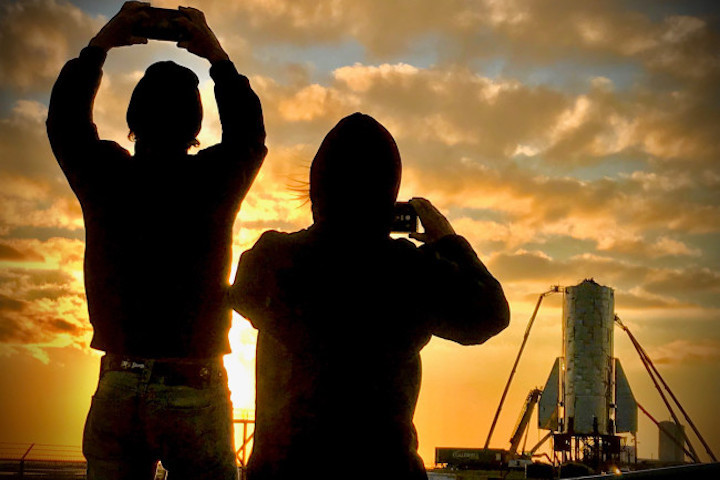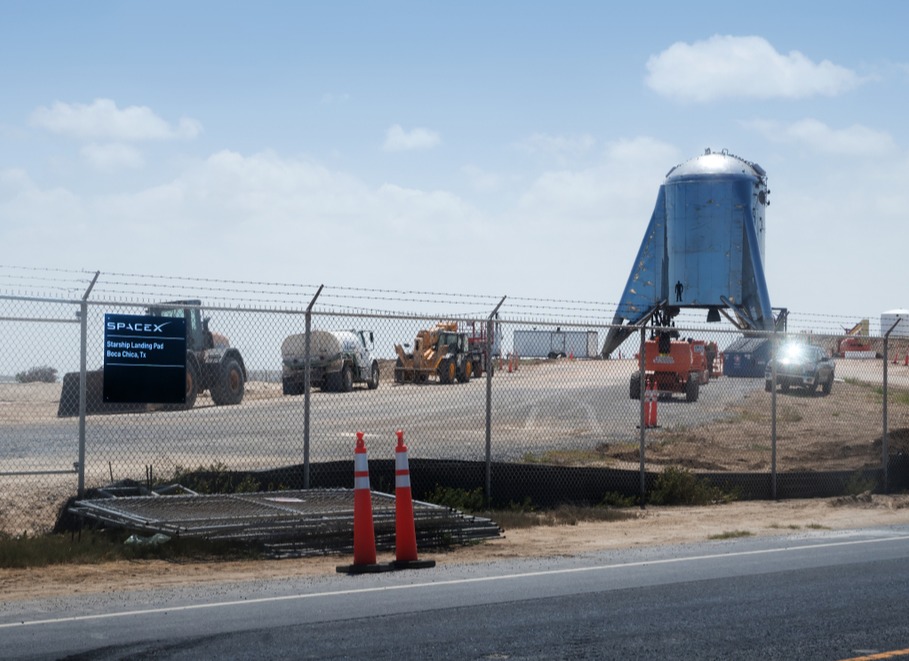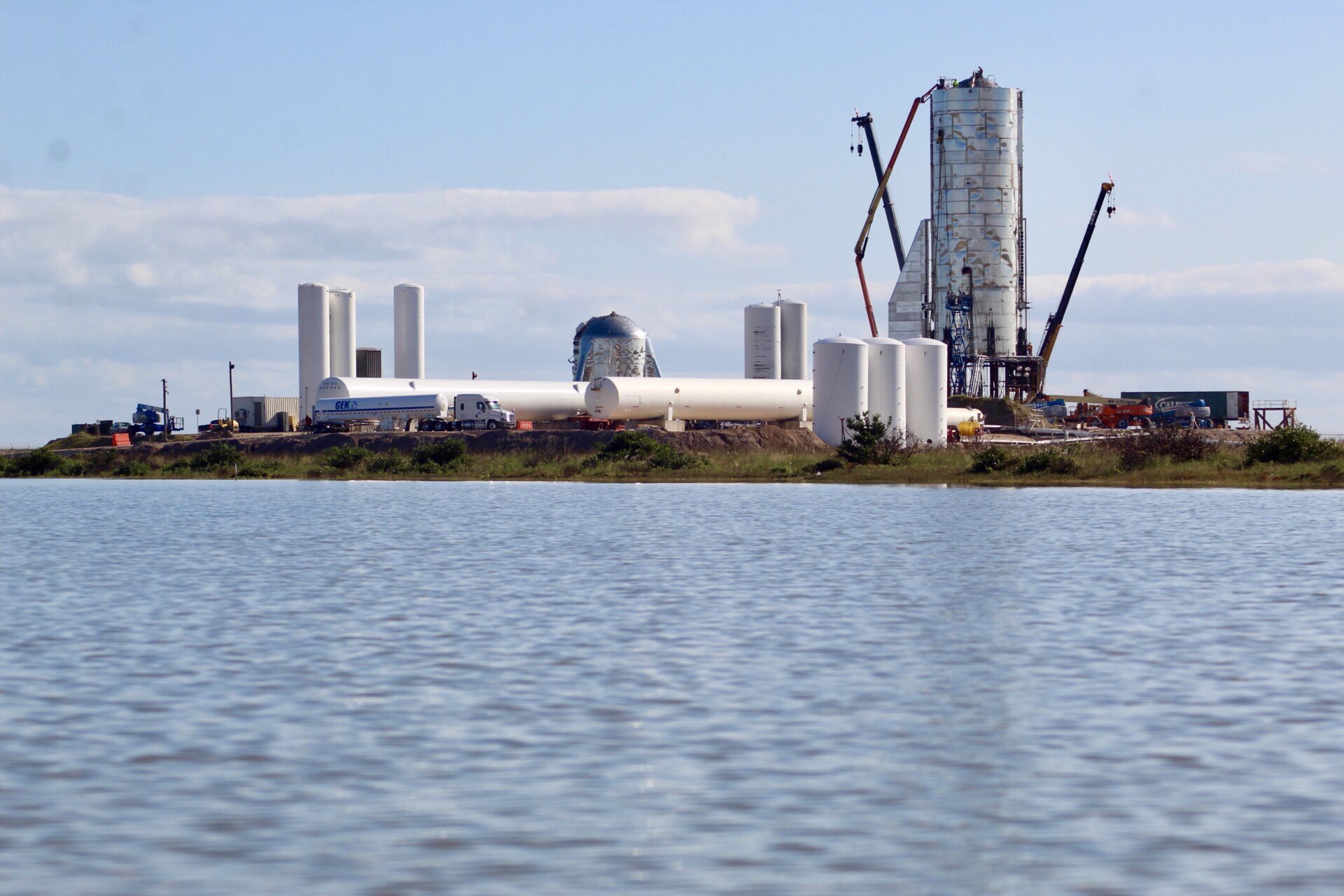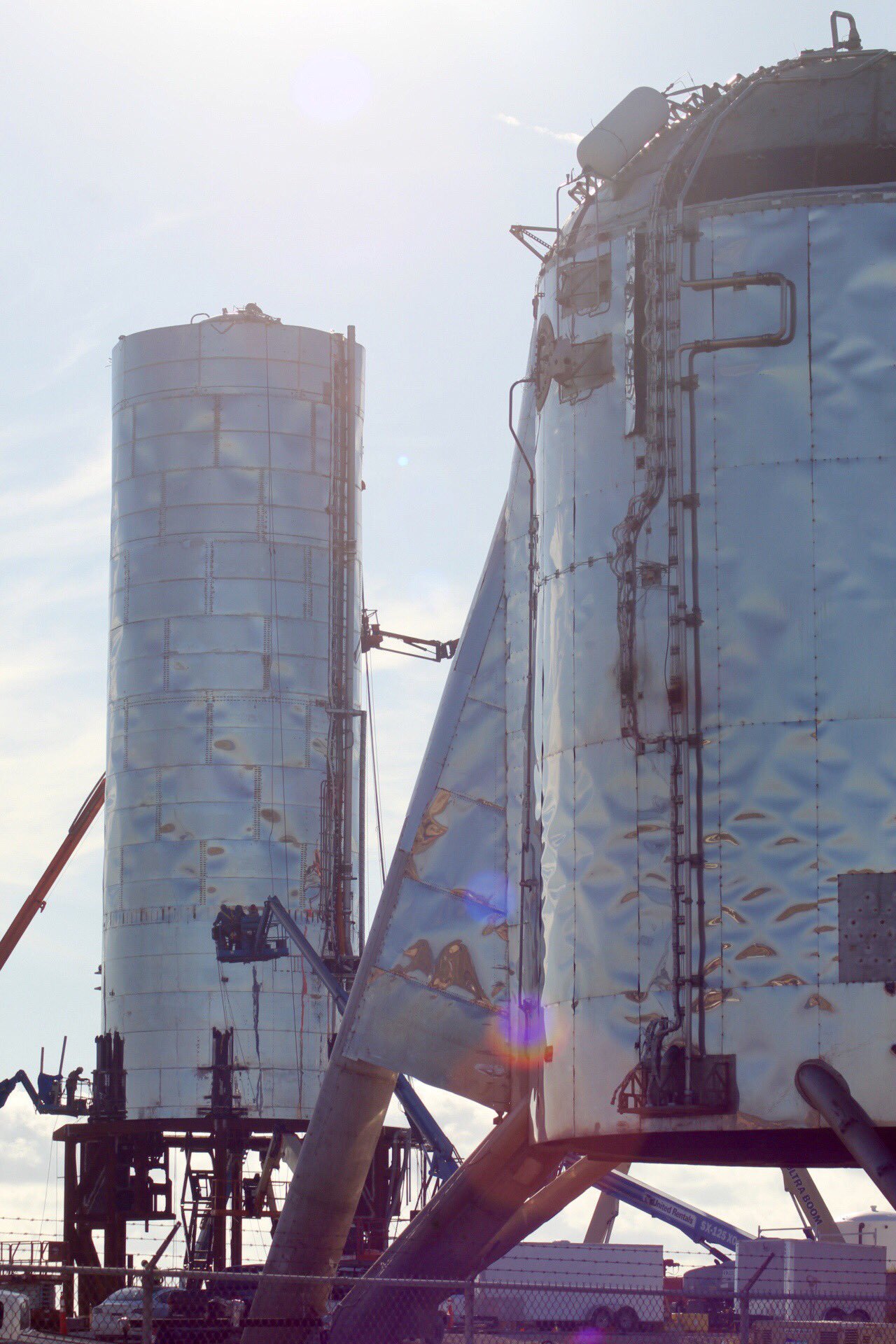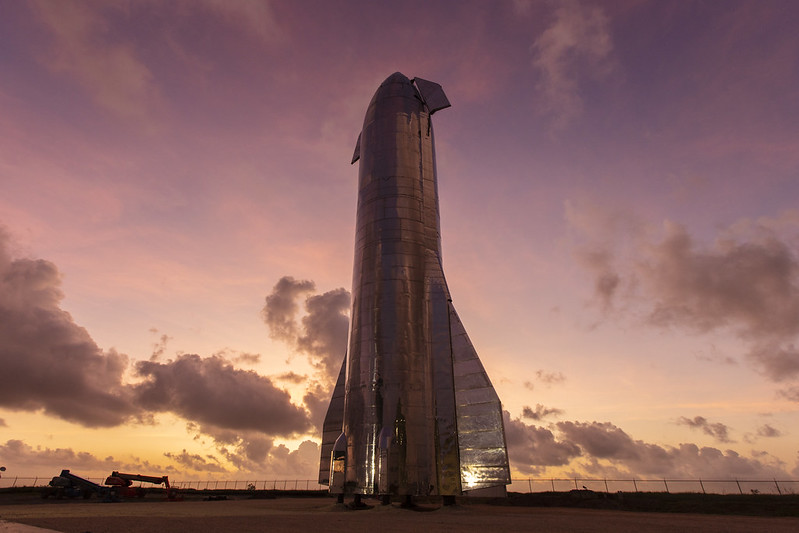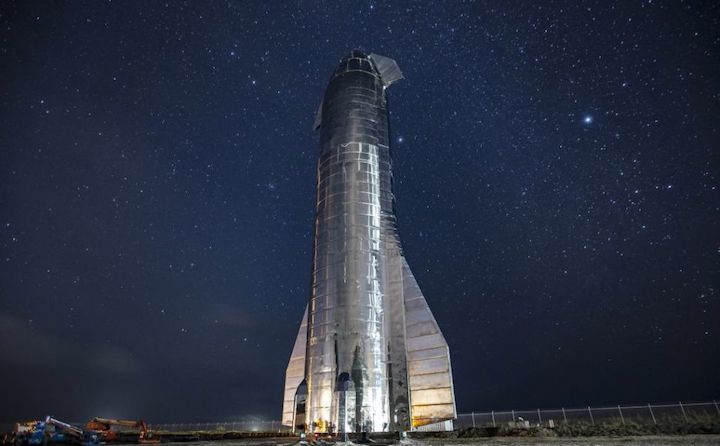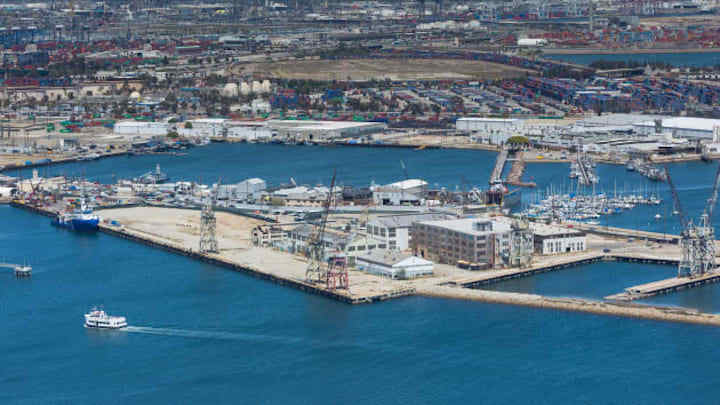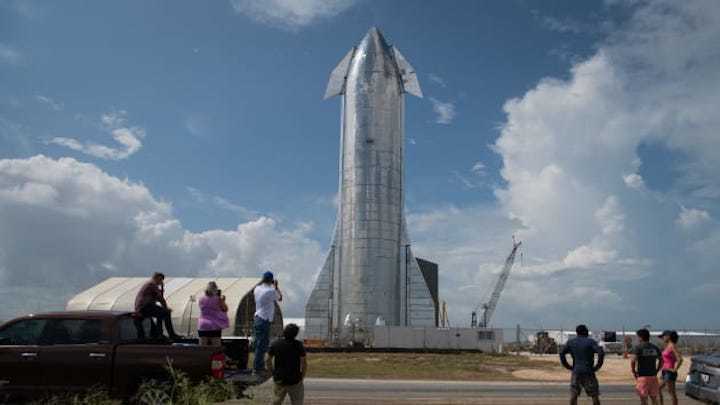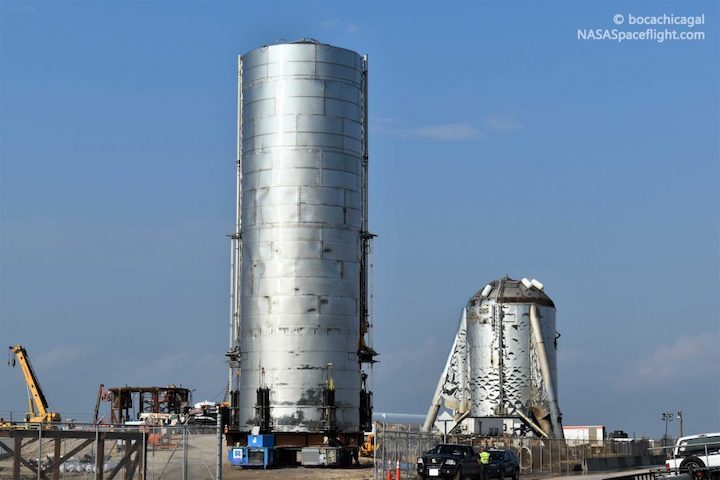SpaceX is already planning the next big test flight of its future Starship rocket out of southern Texas. As early as mid-March, the company is hoping to fly a test version of the vehicle to a super high altitude and then land it upright on solid ground, proving the rocket can be reused and potentially touch down on other worlds.
The upcoming test is detailed in new paperwork SpaceX filed with the Federal Communications Commission, which provides licensing to aerospace companies that are hoping to fly their vehicles to space. Specifically, the FCC allocates which radio frequencies companies can use to communicate with their vehicles during flight.
SpaceX notes in its filing that it wants special authority to communicate with its Starship rocket while the vehicle flies to an altitude of 12.4 miles or 20 kilometers — nearly halfway to the edge of space. Starship would take off from SpaceX’s test facility at Boca Chica, Texas, and the company would attempt to land the vehicle near the launch site using the rocket’s Raptor engines. SpaceX also plans to send data of the vehicle’s trajectory to both the Air Force and NASA.
Such a test would be a significant step forward in the development of Starship, a massive new rocket that SpaceX is building to send people to deep space. Once complete, Starship is meant to launch into orbit on top of an equally massive rocket booster — called the Super Heavy — and then travel onward to distant destinations like the Moon and Mars. CEO Elon Musk has claimed that Starship will be able to lift more than 100 metric tons of payload or carry up to 100 passengers at a time.
That future is still a long way off, though. So far, SpaceX has done ignition tests of Starship’s Raptor engines, and last year, the company flew a scaled-down prototype of Starship to a height of 500 feet, successfully landing the vehicle upright afterward. In September, Musk boldly predicted that Starship would be flying to orbit within the first quarter of this year. However, that timeline likely won’t pan out. A test version of Starship blew its top during a pressure test in November, and the company decided to scrap flying that vehicle altogether. Since then, SpaceX has been working on new test vehicles out of Boca Chica, and the company is reportedly considering the idea of manufacturing Starship rockets out of Los Angeles again.
Still, flying any Starship vehicle above 12 miles will be a big step toward sending the rocket to orbit. SpaceX’s FCC filing requests permission to fly as early as March 16th, though it’s possible the test might not occur for a while. The filing requests quite a long window, giving the company until September 16th to perform this high-altitude flight.
While SpaceX preps for this flight, the company is also on the lookout for those who want to work on the Starship program. Musk announced on Twitter that SpaceX is hosting a career day this Thursday in order to staff up people to oversee Starship development at Boca Chica. Musk noted that people need to have “a super hardcore work ethic, talent for building things, common sense & trustworthiness.” People can be trained on all the other requirements for the jobs, Musk said.
Quelle: The Verge
----
Update: 8.02.2020
.
SpaceX is holding a Starship career day to ramp up its Mars colonization effort
And the company wants to launch a Starship 12 miles up by September.

SpaceX wants to put the pedal to the metal on its Starship Mars colonization system.
The company is hosting a Starship career day today (Feb. 6) at its facility near the South Texas village of Boca Chica, where the big spaceship is coming together.
"This is mainly for staffing up 4 production shifts for 24/7 operations, but engineers, supervisors & support personnel are certainly needed too. A super hardcore work ethic, talent for building things, common sense & trustworthiness are required, the rest we can train," SpaceX founder and CEO Elon Musk said via Twitter Tuesday (Feb. 4).
That explanation came a day after another tweet, in which Musk stressed that Starship production is already humming along. "Going max hardcore on design/production Starship here in Boca. It's awesome! Feels a bit like a Mars simulator," the billionaire entrepreneur wrote. ("Hardcore" appears to be the term of the moment.)
Starship is a 165-foot-tall (50 meters) spacecraft that SpaceX is building to take people to and from Mars, the moon and other distant destinations. The ship will launch off Earth atop a huge rocket called Super Heavy; both of these vehicles will be reusable. (Starship is powerful enough to get itself off the moon and Mars, both of whose gravitational clutches are much weaker than Earth's.)
The only version of Starship to get off the ground to date is a single-engine prototype called Starhopper, which made a few brief test flights last year before being retired. But that could change soon; SpaceX has filed paperwork with the U.S. Federal Communications Commission to launch a 12-mile-high (20 kilometers) test flight with Starship between March and September of this year, The Verge reported.
Things will move quickly after that, if all goes according to SpaceX's plan. Company representatives have said that the first operational Starship missions, which will likely loft commercial communications satellites, could launch as early as 2021.
And SpaceX has one crewed Starship mission on the docket already: Japanese billionaire Yusaku Maezawa booked the vehicle on an around-the-moon flight, with a targeted launch date of 2023.
Quelle: SC
----
Update: 20.02.2020
.
SpaceX beginning final assembly of Starship SN1 ahead of roll to the pad
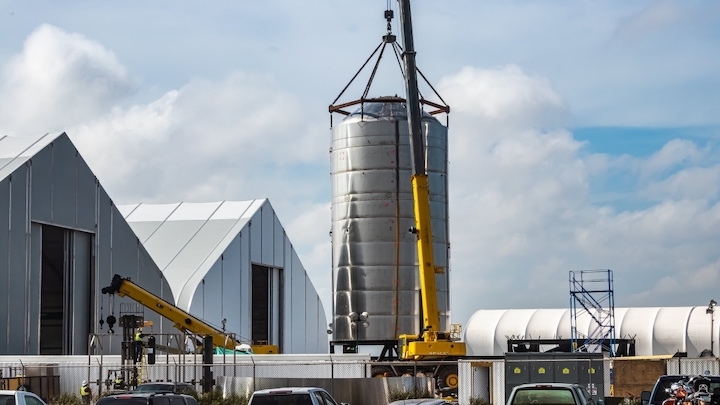
SpaceX teams have begun stacking Starship SN1 in Boca Chica, Texas. The rocket is gearing up for its first flight, which will see the vehicle fly to around 20 kilometers in altitude and then propulsively land back at the launch facility.
(Lead Photo by Jack Beyer for NSF)
SN1 is SpaceX’s second Starship vehicle to be built in Boca Chica. The original Starship – named Mk1 – failed cryogenic pressurization testing. The failure prevented Mk1 from getting the chance to fire its three Raptor engines.
SN1 is currently intended to be SpaceX’s first Starship to perform a flight.
Unlike the Mk1 build, where SpaceX began stacking the vehicle from the beginning of production, teams are taking a more pragmatic approach with SN1.
Instead, the vehicle is being assembled in smaller chunks which will then be welded together during final assembly.
SpaceX recently stacked two of the chunks together to complete the majority of SN1’s tank section. Due to the sections being mostly completed before stacking, the final assembly of SN1 should occur much faster than Mk1.
It is understood that SpaceX is currently hoping to have the entire vehicle stacked and moved to the pad by the end of the month.
If all goes well, a static fire of the SN1 vehicle’s three Raptor engines could then occur in early March, potentially setting the stage for the 20 kilometer hop within a few weeks of the static fire.
However, due to the fluid nature of test campaigns, setbacks and schedule slips are likely. Unfavorable weather is also forecasted over the next few days, potentially leading to additional delays.
While this timeframe may sound ambitious given that only the tank section of the vehicle has been stacked together so far, all of the remaining sections of SN1 are currently being stored inside of the tents in Boca Chica.
SpaceX has been rapidly adding additional tents to support Starship production. The new structures have helped shield the teams and the hardware from the harsh South Texas weather.
A second windbreak is also being assembled and is far taller than the original. The new windbreak is tall enough to also support the eventual assembly of a Super Heavy booster – the first stage for the complete Starship-Super Heavy launch system.
A primary point of improvement for the SN1 test vehicle has been the quality of the steel barrels, which make up the rocket’s primary structure. A side-by-side comparison of the SN1 barrels next to the Mk1 barrels shows far fewer welds on the newer barrels.

Mk1’s fairing stands next to SN1’s stack via Jack Beyer for NSF L2
Over the past several weeks, SpaceX has built and tested several prototype tank sections based on the improved production techniques. Teams have made solid progress, with the most recent test successfully handling 8.5 bar at cryogenic temperatures.
Once SN1 is at the pad, SpaceX will likely perform a wet dress rehearsal – where the Starship is fully loaded with propellants – to ensure that the full-scale vehicle properly handles the cryogenic fuels.
Teams will then perform fuel preburner and ignitor tests with the three Raptor engines before eventually moving into the static fire test.
If all goes well, SpaceX will then proceed with the 20-kilometer hop.
While SN1 remains the company’s short term focus, SpaceX is also quickly preparing for the future of Starship production.
Numerous other facilities across the country are being readied for production to ramp up.

Flyby Photo of McGregor – Photo by Gary Blair for NSF/L2
At the company’s test facility in McGregor Texas, SpaceX recently completed the first hot firing of a Raptor engine on the iconic tripod stand.
The tripod stand was previously used for static fires of the Falcon 9 rocket but was sidelined when an upgraded test stand for Falcon 9 was built. Due to a need for a vertical Raptor test stand, SpaceX began modifying the tripod stand to support Raptor engine tests in the final months of 2019.
Raptor is the methane-fueled engine that will power SpaceX’s Starship and Super Heavy vehicles.
Additional Starship activity was also recently spotted by NASASpaceflight.com photographer Nathan Barker at SpaceX’s Landing Zone 1 at Cape Canaveral Air Force Station.

Raptor stand construction near LZ-1 via Nathan Barker for NSF L2
A Starship-like tank section appears to be under construction near the landing zone. It is understood that SpaceX plans to build a Raptor test stand at the facility.
Finally, on the west coast, SpaceX intends to once again build a Starship production facility at the Port of LA. The company pulled out of a lease agreement with the port last year after deciding to focus on building the vehicles in Texas and Florida instead.
SpaceX is now interested in a new agreement to utilize the Berth 240 at the Port of LA, as the company has decided that additional production real estate will be required to supplement their existing facilities.
Quelle: NS
----
Update: 21.02.2020
.
SpaceX wants to build its Mars Starship at Port of L.A. — again
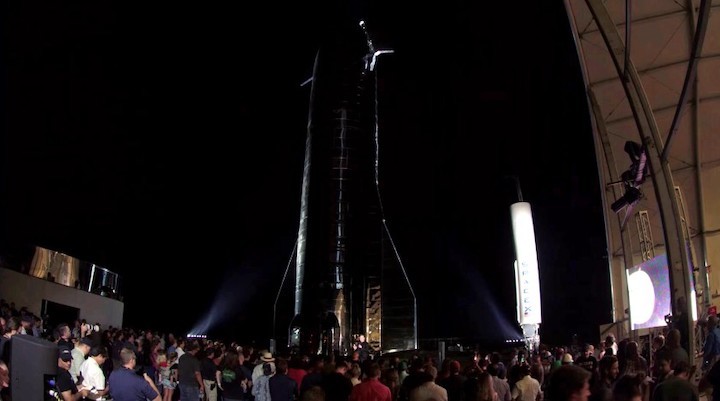
SpaceX created excitement in 2018 when it said it would build its Mars spaceship and rocket at the Port of Los Angeles, striking a deal to lease a swath of Terminal Island for the purpose.
Early last year, it changed its mind and moved the work to Texas.
Now it wants back in — and officials are poised to grant its wish.
The L.A. Board of Harbor Commissioners voted Thursday to approve a new permit for Elon Musk-led SpaceX to lease that same piece of land and establish and re-purpose facilities there to make aerospace products. The prime candidate: SpaceX’s Mars system, known as Starship.
The deal still needs approval from the L.A. City Council, which is scheduled to take up the matter next week.
“I’m really excited to see what SpaceX will be able to bring for the future of not only space exploration and technology in Los Angeles, but also to the Port of Los Angeles,” Board of Harbor Commissioners President Jaime Lee said minutes before Thursday’s vote.
The Starship project’s return to the Port of L.A. began last month, when SpaceX contacted the Harbor Department and City Councilman Joe Buscaino. The Hawthorne-based company had been building Starship prototypes at its facility near Boca Chica Village in Texas, but it needed additional manufacturing capacity, SpaceX told Buscaino’s office.
SpaceX wants a spot by the water because the spacecraft and parts it plans to manufacture will be too large to transport by road and must be taken to the eventual launch site — which could be in Texas or Florida — by barge or ship.
The company already has a foothold at the port: When it launches satellites from Vandenberg Air Force Base near Lompoc, it often lands the reusable first-stage rocket boosters on a floating platform in the Pacific Ocean, then brings them back to a berth at the Port of L.A.
“I’m confident that we’re doing our part in securing this lease and keeping [SpaceX] here for the long haul,” Buscaino said last week. “The lesson I’ve learned is, because this industry is so fluid, there could be surprises along the way. And I’m hopeful that the surprise is the expansion of the workforce.”
The SpaceX facility could create 130 jobs, according to a documentfrom the Port of L.A. That’s far fewer than in the 2018 proposal, which predicted the creation of about 700 jobs.
The new proposal does not include construction jobs. SpaceX didn’t submit a construction plan because the company is not sure what it will eventually build, said Marisa Katnich, the port’s director of cargo and industrial real estate. For now, SpaceX plans to refurbish five buildings at the site and may also raise a tent-like structure.
SpaceX plans to use its port facility for research, design and manufacturing. Although a SpaceX representative did not mention Starship during his presentation at Thursday’s meeting, he noted that one of the company’s goals is to create an interplanetary society and that Mars is part of that plan.
SpaceX says on its website that this year, it hopes to launch Starship on a test flight that — rather than aiming for Mars — would reach Earth’s orbit. In the past, the company has said its “aspirational” goal is to send cargo missions to Mars in 2022.
“We have ambitious goals for the [L.A. port] site, ambitious timetables,” said Matthew Thompson, senior director of environmental health and safety at SpaceX.
In withdrawing from the L.A. site last year, SpaceX said it had decided to build and test the Starship prototype in south Texas to “streamline operations.”
The company tests rocket engines and other components in McGregor, Texas. It builds Falcon 9 rockets and Dragon capsules and does its main design, engineering and manufacturing work in Hawthorne, and it launches from Florida as well as from Vandenberg Air Force Base.
During Thursday’s meeting, Harbor Commissioner Lucia Moreno-Linares noted last year’s reversal of plans and said she hoped that this time, “everybody delivers on their promises.”
The initial permit covers 12.4 acres at the former Southwest Marine site at Terminal Island, with an option to expand to 19 acres. It would last 10 years. SpaceX could then opt for two 10-year extensions.
The Southwest Marine site at Berth 240 has been derelict for 15 years. The location was first developed for shipbuilding in 1918 and was acquired by Bethlehem Shipbuilding Corp. not long after. During the heyday of World War II production, the shipyard produced about 40 Navy destroyers and employed 6,000 people.
Quelle: Los Angeles Times
----
Update: 28.02.2020
.
SpaceX Starship rolls to Texas launch pad ahead of next big test campaign
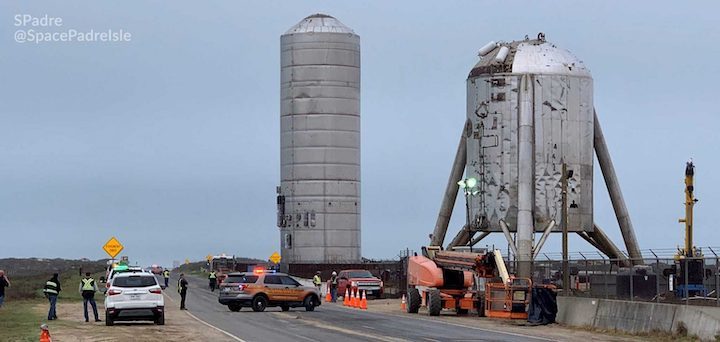
SpaceX’s first flightworthy Starship prototype has rolled to its South Texas launch pad just hours after it was welded together and is now preparing for several critical tests it must pass before it can be deemed ready for liftoff.
Fabricated and assembled with incredible speed at SpaceX’s growing Boca Chica, Texas Starship factory and test facilities, the vehicle SpaceX moved to the launch pad earlier today (Feb 25) is meant to become the first full-scale Starship prototype to take flight. Following in the footsteps of the Starship Mk1 prototype, deemed too shoddy to launch and pressurized to destruction in November 2019, the first serial build (SN01) of an improved line of Starship prototypes appears to have taken less than a month to go from first weld to the launch pad.
CEO Elon Musk took to Twitter earlier today to confirm the Starship SN01 tank section’s move to the launch pad, further noting that the tank assembly is now preparing for Raptor engine installation ahead of a static fire test. According to NASASpaceflight.com, SpaceX wants to complete that static fire and launch Starship SN01 as early as next month – a seemingly improbable target that just got much more likely with the rocket’s tank section already at the launch pad. Most importantly, however, the speed with which SpaceX has been able to assemble and prepare Starship SN01 suggests that even if things go wrong or plans change, another completed prototype could be ready to head to the pad just a few weeks from now.
On February 25th, SpaceX CEO Elon Musk posted a screenshot taken from a livestream created by SPadre earlier that day, noting that Starship will soon have engines installed in preparation for a critical static fire test.
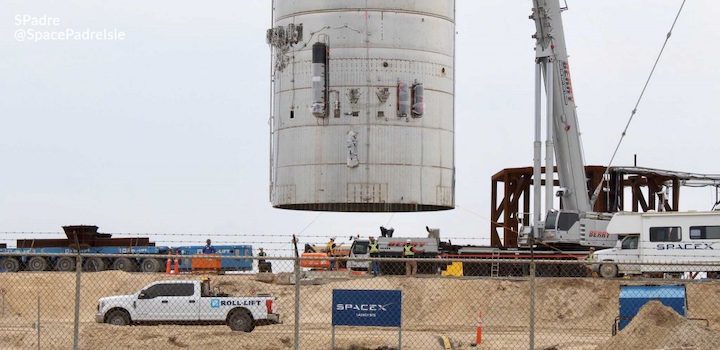
Under the cover of an incredibly thick fog bank, Starship SN01 was lifted onto a Roll Lift transporter and carefully moved from its factory facilities to SpaceX’s Boca Chica launch pad at 4:30 am PST. Around 7:30 am PST, the giant rocket tank was lifted onto the pad’s Starship mount and technicians have been working to connect SN01 to the ground systems ever since.
Built out of stainless steel, Starship SN01’s tank section – referring to the combined liquid oxygen tank, liquid methane tank, and engine section – stands about 30m (100 ft) tall and likely weighs at least 30-45 metric tons (~70,000-100,000 lb) as it stands. While SN01 is clearly missing its pointed nose section (‘nosecone’) and flaps, among other parts, its tank section has been moved to the launch pad to perform tests that don’t involve the ship’s aerodynamic properties.
Starship Mk1 – SpaceX’s first attempt at a full-scale prototype – was fabricated and stacked piece by piece over the course of nine months before its tank section – looking almost identical to SN01 – first rolled to SpaceX’s launch pad on October 30th, 2019. Three weeks later, it was intentionally pressurized until it popped after engineers concluded that its production quality was too low for a flight test attempt to be worth the effort. On the other hand, the first of Starship SN01’s steel rings was definitively completed in the last week of January 2020, quite possibly just four weeks before the completed tank section was rolled to the same launch pad.
With that kind of speed, it’s no surprise that Musk says SpaceX will start stacking Starship SN02’s tank section this week. Intriguingly, Musk also stated that Starship SN02 would have three Raptors installed, avoiding the original question’s focus (SN01). As such, it appears that Starship SN01 may only have one Raptor installed for a static fire test and would be unlikely to ever fly if that were the case. It’s possible that after two highly successful (and explosive) pressure tests of smaller Starship test tanksthat were completed last month, SpaceX still wants to perform a similar pressure test with a fully-integrated, full-scale Starship tank section to confirm that the smaller tank results carry over.

